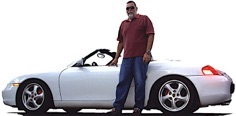
Published in the December 2012 issue of “Die Porsche Kassette”
Electronic Stability Control is known by many acronyms and names, such as: AdvanceTrac, Dynamic Stability Control (DSC), Dynamic Stability and Traction Control (DSTC), Electronic Stability Program (ESP), Vehicle Dynamic Control (VDC), Vehicle Stability Assist (VSA), Vehicle Stability Control (VSC), Vehicle Skid Control (VSC), Vehicle Stability Enhancement (VSE), StabiliTrac and last but not least, Porsche Stability Management (PSM).
But what is it?
A vehicle’s Electronic Stability System uses on board computers to control each individual wheel’s brakes and assists the driver in maintaining control of the vehicle by keeping the vehicle headed in the direction the driver is steering, even when the vehicle nears or reaches the limits of road traction.
When a driver attempts a sudden corrective maneuver, for instance to avoid a crash or because (s)he misjudged the severity of a curve, (s)he may lose control if the vehicle responds differently than expected as it reaches the limits of road traction than it does in ordinary driving.
This loss of control can result in either the tail of the vehicle spinning out, or the front of the vehicle plowing out.
As long as there is sufficient traction, an experienced track driver could maintain control in many of these conditions by using countersteering (momentarily turning away from the intended direction of the car) or ...
... as Doc Hudson Hornet (Paul Newman) expertly explained to Lightning McQueen (Owen Wilson):
“turn right to go left”
in the animated movie Cars.
Image courtesy of Pixar Animation Studios

Generally, in panic situations with the vehicle beginning to spin out of control, average drivers would be unlikely to countersteer like a race driver, to regain control.
To help the driver in such a predicament, Porsche Stability Management (PSM) or any other form of ESC uses automatic braking of the individual wheels to adjust the vehicle’s heading if it departs from the direction the driver is steering. Therefore it prevents the heading from changing too quickly (spinning out) or not quickly enough (plowing out). ESC cannot increase the available traction. It only affords the driver the maximum possibility of keeping the vehicle under control and on the road in an emergency maneuver using just the natural reaction of steering in the intended direction.
But Porsche has gone way beyond the requirements for ESC by the introduction of PTV (Porsche Torque Vectoring) for manual transmissions and PTV Plus for cars equipped with Porsche Doppelkupplung (PDK).
PTV and PTV Plus are optional systems which increase the dynamic performance and stability of the car by varying the distribution of torque to the rear wheels. These systems include a mechanically locking rear differential.
Images courtesy of Dr. Ing. h.c.F Porsche AG

When the car is driven aggressively into a corner, some brake pressure is applied to the inside rear wheel. Thus, a greater amount of drive force is distributed to the outside rear wheel, inducing an additional rotational pulse (yaw movement) around the vehicle’s vertical axis.
Some people complain that all of these “nanny” controls are taking away the fun of driving but at least in Porsche’s case, you can switch off the function (PSM). Well, almost. Porsche’s PSM remains set to intervene if the vehicle is braked and ABS assistance is required.
One great feature of PSM is brake precharging. If you suddenly release the accelerator pedal, PSM automatically prepares for your next action: the braking system is precharged so that the brake pads are already in light contact with the rotors and maximum braking power is achieved much sooner. When brake assist detects a panic braking situation it generates the optimal braking pressure required for maximum deceleration. Neat stuff!
As part of a comprehensive plan to reduce the serious risk of rollover crashes and the risk of death and serious injury in those crashes, The Federal Motor Vehicle Safety Standards Rule No. 126 requires ESC systems on all passenger cars, multipurpose passenger vehicles, trucks and busses sold in the US with a gross vehicle weight rating of 10,000 lbs or less as of model year 2012.
The National Highway Transportation Administration (NHTSA) estimates that ESC technology will reduce single-vehicle crashes of passenger cars by 34% and single vehicle crashes of SUVs by 59%.
To learn more about Porsche Stability Management and more, please visit my website at: www.PedrosGarage.com
Happy Porscheing,
Ⓒ2012 Technolab / PedrosGarage.com


